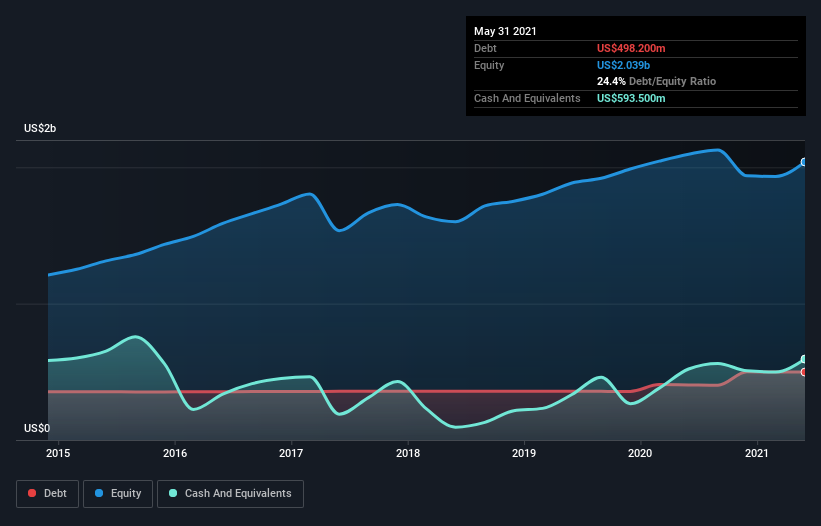Is Acuity Brands (NYSE:AYI) A Risky Investment?
Howard Marks put it nicely when he said that, rather than worrying about share price volatility, 'The possibility of permanent loss is the risk I worry about... and every practical investor I know worries about.' It's only natural to consider a company's balance sheet when you examine how risky it is, since debt is often involved when a business collapses. Importantly, Acuity Brands, Inc. (NYSE:AYI) does carry debt. But the real question is whether this debt is making the company risky.
Why Does Debt Bring Risk?
Debt assists a business until the business has trouble paying it off, either with new capital or with free cash flow. Ultimately, if the company can't fulfill its legal obligations to repay debt, shareholders could walk away with nothing. However, a more frequent (but still costly) occurrence is where a company must issue shares at bargain-basement prices, permanently diluting shareholders, just to shore up its balance sheet. Of course, debt can be an important tool in businesses, particularly capital heavy businesses. The first step when considering a company's debt levels is to consider its cash and debt together.
Check out our latest analysis for Acuity Brands
How Much Debt Does Acuity Brands Carry?
You can click the graphic below for the historical numbers, but it shows that as of May 2021 Acuity Brands had US$498.2m of debt, an increase on US$403.6m, over one year. But it also has US$593.5m in cash to offset that, meaning it has US$95.3m net cash.
How Healthy Is Acuity Brands' Balance Sheet?
We can see from the most recent balance sheet that Acuity Brands had liabilities of US$671.4m falling due within a year, and liabilities of US$849.8m due beyond that. Offsetting this, it had US$593.5m in cash and US$509.0m in receivables that were due within 12 months. So it has liabilities totalling US$418.7m more than its cash and near-term receivables, combined.
Given Acuity Brands has a market capitalization of US$6.00b, it's hard to believe these liabilities pose much threat. Having said that, it's clear that we should continue to monitor its balance sheet, lest it change for the worse. While it does have liabilities worth noting, Acuity Brands also has more cash than debt, so we're pretty confident it can manage its debt safely.
The good news is that Acuity Brands has increased its EBIT by 5.4% over twelve months, which should ease any concerns about debt repayment. The balance sheet is clearly the area to focus on when you are analysing debt. But it is future earnings, more than anything, that will determine Acuity Brands's ability to maintain a healthy balance sheet going forward. So if you're focused on the future you can check out this free report showing analyst profit forecasts.
Finally, while the tax-man may adore accounting profits, lenders only accept cold hard cash. While Acuity Brands has net cash on its balance sheet, it's still worth taking a look at its ability to convert earnings before interest and tax (EBIT) to free cash flow, to help us understand how quickly it is building (or eroding) that cash balance. Over the last three years, Acuity Brands recorded free cash flow worth a fulsome 96% of its EBIT, which is stronger than we'd usually expect. That positions it well to pay down debt if desirable to do so.
Summing up
While it is always sensible to look at a company's total liabilities, it is very reassuring that Acuity Brands has US$95.3m in net cash. The cherry on top was that in converted 96% of that EBIT to free cash flow, bringing in US$396m. So we don't think Acuity Brands's use of debt is risky. Over time, share prices tend to follow earnings per share, so if you're interested in Acuity Brands, you may well want to click here to check an interactive graph of its earnings per share history.
If, after all that, you're more interested in a fast growing company with a rock-solid balance sheet, then check out our list of net cash growth stocks without delay.
This article by Simply Wall St is general in nature. We provide commentary based on historical data and analyst forecasts only using an unbiased methodology and our articles are not intended to be financial advice. It does not constitute a recommendation to buy or sell any stock, and does not take account of your objectives, or your financial situation. We aim to bring you long-term focused analysis driven by fundamental data. Note that our analysis may not factor in the latest price-sensitive company announcements or qualitative material. Simply Wall St has no position in any stocks mentioned.
Have feedback on this article? Concerned about the content? Get in touch with us directly. Alternatively, email editorial-team (at) simplywallst.com.

 Yahoo Finance
Yahoo Finance 
